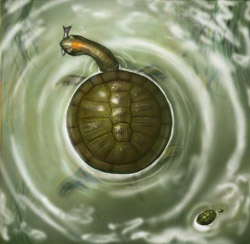Fossil turtle from Colombia round like car tire

The round shape of a new species of fossil turtle found in Cerrejon coal mine in Colombia may have warmed readily in the sun. Credit: Liz Bradford<br>
The new turtle species is named Puentemys mushaisaensis because it was found in La Puente pit in Cerrejón Coal Mine, a place made famous for the discoveries, not only of the extinct Titanoboa, the world's biggest snake, but also of Carbonemys, a freshwater turtle as big as a smart car.
Cerrejon's fossil reptiles all seem to be extremely large. With its total length of 5 feet, Puentemys adds to growing evidence that following the extinction of the dinosaurs, tropical reptiles were much bigger than they are now. Fossils from Cerrejon offer an excellent opportunity to understand the origins of tropical biodiversity in the last 60 million years of Earth's history.
The most peculiar feature of this new turtle is its extremely circular shell, about the size and shape of a big car tire. Edwin Cadena, post-doctoral fellow at North Carolina State University and lead author of the paper, said that the turtle's round shape could have discouraged predators, including Titanoboa, and aided in regulating its body temperature.
The width of the turtle's shell probably exceeded the maximum expansion of the Titanoboa's mouth. Its circular, low-domed shape would have increased the area of the body exposed to the sun, helping the cold-blooded turtle warm to a temperature at which it was more active.
The Smithsonian Tropical Research Institute, headquartered in Panama City, Panama, is a unit of the Smithsonian Institution. The Institute furthers the understanding of tropical nature and its importance to human welfare, trains students to conduct research in the tropics and promotes conservation by increasing public awareness of the beauty and importance of tropical ecosystems. Website: www.stri.si.edu.
Reference: Cadena, E.A., Bloch, J.I., and Jaramillo, C.A. 2012. New Bothremydid turtle (Testudines, Pleurodira) from the Paleocene of Northeastern Colombia. Journal of Paleontology, 86(4):689-699.
Authors and Institutions:
Edwin A. Cadena, Florida Museum of Natural History, North Carolina State University
Jonathan I. Bloch, Florida Museum of Natural History
Carlos A. Jaramillo, Smithsonian Tropical Research Institute
Media Contact
All latest news from the category: Earth Sciences
Earth Sciences (also referred to as Geosciences), which deals with basic issues surrounding our planet, plays a vital role in the area of energy and raw materials supply.
Earth Sciences comprises subjects such as geology, geography, geological informatics, paleontology, mineralogy, petrography, crystallography, geophysics, geodesy, glaciology, cartography, photogrammetry, meteorology and seismology, early-warning systems, earthquake research and polar research.
Newest articles

A universal framework for spatial biology
SpatialData is a freely accessible tool to unify and integrate data from different omics technologies accounting for spatial information, which can provide holistic insights into health and disease. Biological processes…

How complex biological processes arise
A $20 million grant from the U.S. National Science Foundation (NSF) will support the establishment and operation of the National Synthesis Center for Emergence in the Molecular and Cellular Sciences (NCEMS) at…

Airborne single-photon lidar system achieves high-resolution 3D imaging
Compact, low-power system opens doors for photon-efficient drone and satellite-based environmental monitoring and mapping. Researchers have developed a compact and lightweight single-photon airborne lidar system that can acquire high-resolution 3D…





















